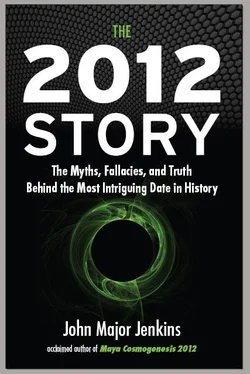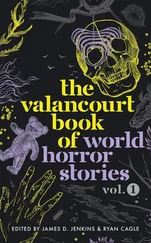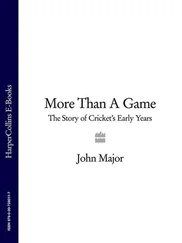This Long Count example didn’t occur on a period ending, such as a Tun ending or a Katun ending. If celestial events occurred perfectly on one of these period endings, future events would more easily fit into the Long Count’s predictive framework. For this, we can look at the Long Count date 9.14.0.0.0—the completion of the 14th Katun of the 9th Baktun. Corresponding to December 3, 711 AD, this particular Long Count period ending is found at Copán, Tortuguero, Tikal, Calakmul, and other sites, suggesting it had a meaning with universal appeal. We should immediately suspect that some unusual astronomy was happening on that date, and indeed it was. First, we have the first appearance of Venus as evening star. On Copán Stela C, which contains this Long Count date, the ruler 18 Rabbit has the Venus emblem in his headgear. Also on this date, the sun was aligned with the dark rift. The popularity of this date may be rooted in this astronomical occurrence, since it evokes the alignment that falls on the cycle ending in 2012 (sun in the dark rift, on the solstice ).
Long Count dates often seem intended to highlight Jupiter and Saturn events, either conjunction, stations, or alignments with sidereal features such as Antares, the Pleiades, or the dark rift in the Milky Way. Research by Maya scholar Susan Milbrath showed that the Katuns of the Long Count were used to track Saturn and Jupiter events, such as stations and maximum elongations. 20Following the work of Floyd Lounsbury, who showed that the deity named Kawil was related to the planet Jupiter, Milbrath tracked the astronomy connected with Kawil-related Long Count dates in the inscriptions, and found definite patterns involving not only Jupiter but Saturn. Both planets can take on the role of Kawil, the serpent-footed lightning deity, often at Katun endings or midpoints. This is because the Jupiter-Saturn conjunction cycle is just under 20 years, and the Katun period is 19.71 years. Classic Period sites such as Tikal, Yaxchilán, and Copán were particularly interested in how the Long Count provided a framework for planetary astronomy.
In the far north at Chichén Itzá, a renaissance occurred in the early ninth century when Central Mexicans flooded into Yucatán. They brought with them traditions such as the New Fire ceremony and a unique blending of Maya and Central Mexican culture occurred. The Long Count already had a long history of use in Yucatán, at sites such as Uxmal, Ek Balam, and Coba, and there was an effort to integrate the Calendar Round system and the Long Count. The Baktun ending of 830 AD may have signaled a new era at Chichén Itzá, triggering the construction of its most enduring monuments, the Great Ballcourt and the Pyramid of Kukulcan.
The famous Long Count date at Coba is interesting because it takes the Long Count far beyond the level of the Baktun. Most dates in the Long Count use only the first five place value levels, but it theoretically can be extended indefinitely. The Coba date is basically the same date as that in the Creation Texts found elsewhere, which identify the end of the last era of 13 Baktuns on August 11, 3114 BC. This is usually written 13.0.0.0.0, but at Coba the previous cyclic periods are also given, such that we have a total of nineteen levels above the Baktun, thousands of times larger than modern science’s estimate for the age of the universe: 13.13.13.13.13.13.13.13.13.13.13.13.13. 13.13.13.13.13.13.13.0.0.0.0. As Anthony Aveni said, it seems that a Baktuno maniac was set loose on this stone. Much has been made of this representation of the Long Count. Some have suggested that it renders the 13-Baktun cycle meaningless. But this is like saying that century periods in our own calendar render the decade periods meaningless.
A distinction must be made between practical calendrics, in which the 13-Baktun period was a standardized doctrine, and theoretical mathematics. The Maya were apparently fond of generating huge numbers, which may have been attempts to find the grand number that would unify all the astronomical cycles. Greek mathematicians attempted the same thing as they grappled with the duration of the Great Year—it was supposed to be a harmonious 36,000 years, according to Plato, but the discovery of the great cycle of the precession of the equinoxes suggests a figure thousands of years less. Perhaps the Maya intended these huge numbers to represent, in a very general sense, the awesome immensity of the universe.
Coba doesn’t disqualify the importance of the 13-Baktun period. In fact, it can be added to the many other examples that point to 13.0.0.0.0, 4 Ahau 8 Cumku, August 11, 3114 BC. There are many examples of this era inauguration being alluded to with only the Calendar Round position. For example, on the famous Vase of the Seven Lords, we see Creation imagery and the date 4 Ahau 8 Cumku. This tzolkin-haab combination corresponds to a period ending in the Long Count very rarely, and that’s how scholars determine it to be a reliable shorthand for the full 13.0.0.0.0 date. Suffice it to say that the Creation Mythology’s “three-stone” symbolism itself was used as a shorthand for the 3114 BC date. 21This practice has important ramifications for understanding how the Maya referenced the 2012 date in their hieroglyphic texts.
Critics have often stated that there are no dates recorded in the inscriptions that point directly to the cycle ending in 2012. This is not true, as we have an important date from Tortuguero, a kingdom near Palenque, that has far-reaching implications. In addition, as we’ll see in Chapter 7, secondary references to the astronomical alignment of era-2012 are found in the inscriptions, just as secondary references to 3114 BC are common. It is this new perspective on textual evidence for 2012 being an intentional and important concept in ancient Maya cosmology that constitutes a very promising new tool for identfying 2012 references in the inscriptions.
The Long Count served as a framework for building dedications, anniversaries of important events in a king’s life, and aided both astronomical calculations and shamanic prophecies. Period endings were treated as important junctures and involved sacrifice and renewal. Maya scholar Dennis Puleston suggested that the Baktun ending of 830 AD may have instigated a breakdown for some Maya cities, a fatalistic expectation that a phase of their existence as a civilization was coming to an end. 22The old Janus-face of cycle endings may have been just as perplexing for the Maya as it is for us today, as the dissolution of one era blends with the birth of a new one. Something drastic definitely occurred around the end of Baktun 10 in 830 AD, which signaled the beginning of the end for the Classic Maya civilization.
The causes of the Classic Maya collapse were many, including changing weather patterns and erosion caused by deforestation and the burning of trees to make lime (used for plaster), as well as increasing greed throughout a proliferation of kingdoms and princedoms. Within the complex network of dozens of Maya cities of the Petén (northern Guatemala), a series of interrelated cascades, including environmental degradation, warfare, drought, and greed, began to take their toll. Populated by over two million people at its height around 750 AD, the Petén’s population dropped by two-thirds in the mid-eighth century. By 900 AD the Classic Maya civilization had ground to a halt. The last Long Count date was carved on the western periphery, at Toniná, in 909 AD.
But the Long Count tracking system did not end there; it just stopped being carved in stone. Just as time had “materialized” with the first stone carvings of the Long Count in the first century BC, it now dematerialized, relegated to the heads of day-keepers and perishable bark paper books. The collapse of civilization was much more severe in the Petén than it was in Yucatán, where Chichén Itzá, Mayapán, and other cities continued to thrive, although beset as usual by warfare and strife. Those cities, too, eventually were abandoned as a different style of culture arose.
Читать дальше












